Historical Research and Evaluation of Fiji Water Authority's I/ERS
VerifiedAdded on 2022/10/31
|7
|1410
|63
Report
AI Summary
This report delves into the industrial relations of the Water Authority of Fiji (WAF), examining its historical context and development. It begins with an introduction outlining the project's scope, followed by a literature review that establishes a theoretical framework, including Unitary and Dunlop's theories. The research methodology employed is then described, setting the stage for the findings, which explore the origins and emergence of the Fijian state, as well as developments related to the WAF. The report analyzes the three key components of the WAF – input, transformation process, and output – and assesses their advantages, disadvantages, and links to employee motivation. The discussion section provides a deeper insight into the state's evolution and the impact of the WAF's initiatives, including improvements in water treatment and infrastructure. Finally, the report recommends a suitable IR model for Fiji, based on a fuzzy retrieval approach, and concludes by summarizing the key findings and their implications for the WAF and the Fijian population.
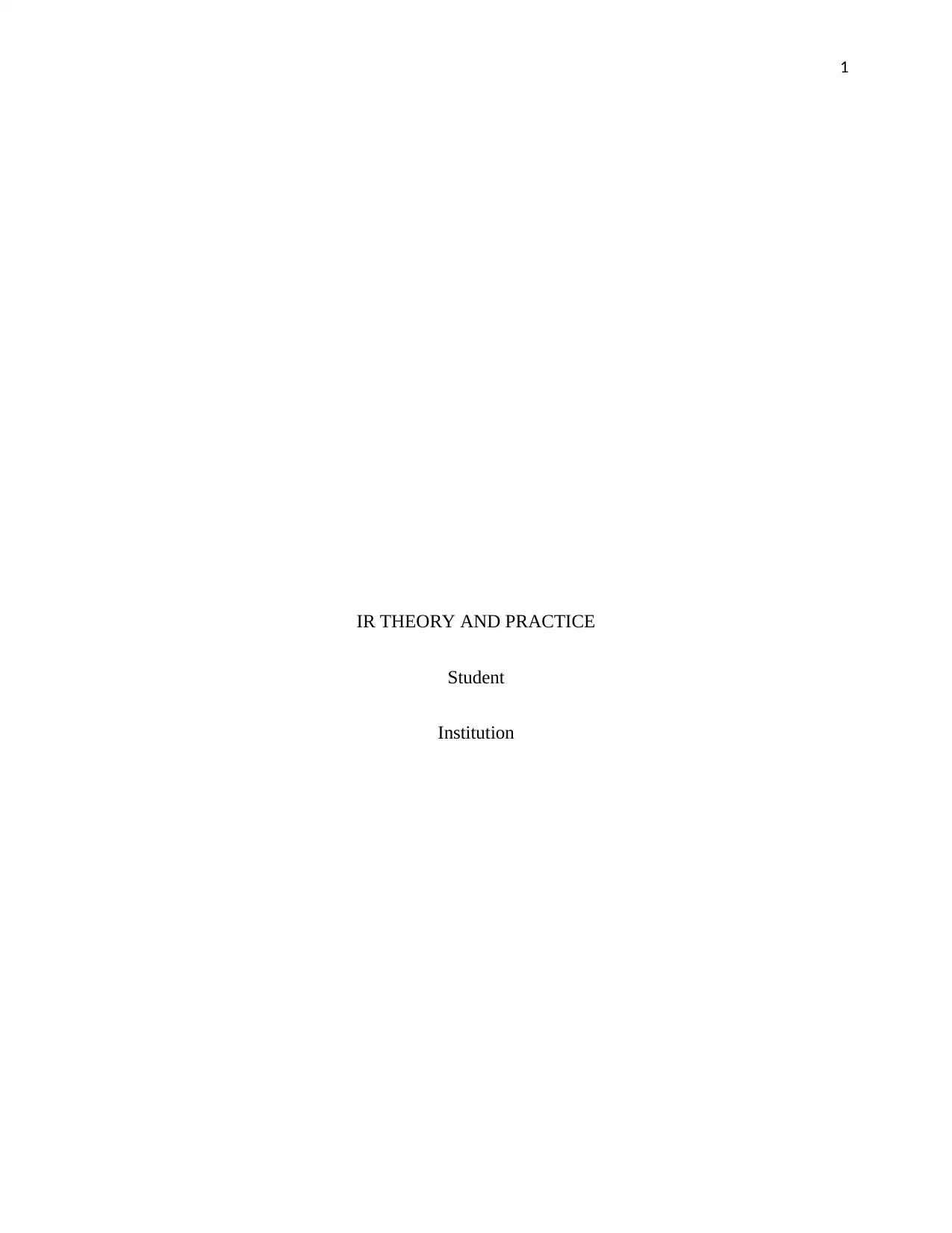
1
IR THEORY AND PRACTICE
Student
Institution
IR THEORY AND PRACTICE
Student
Institution
Paraphrase This Document
Need a fresh take? Get an instant paraphrase of this document with our AI Paraphraser
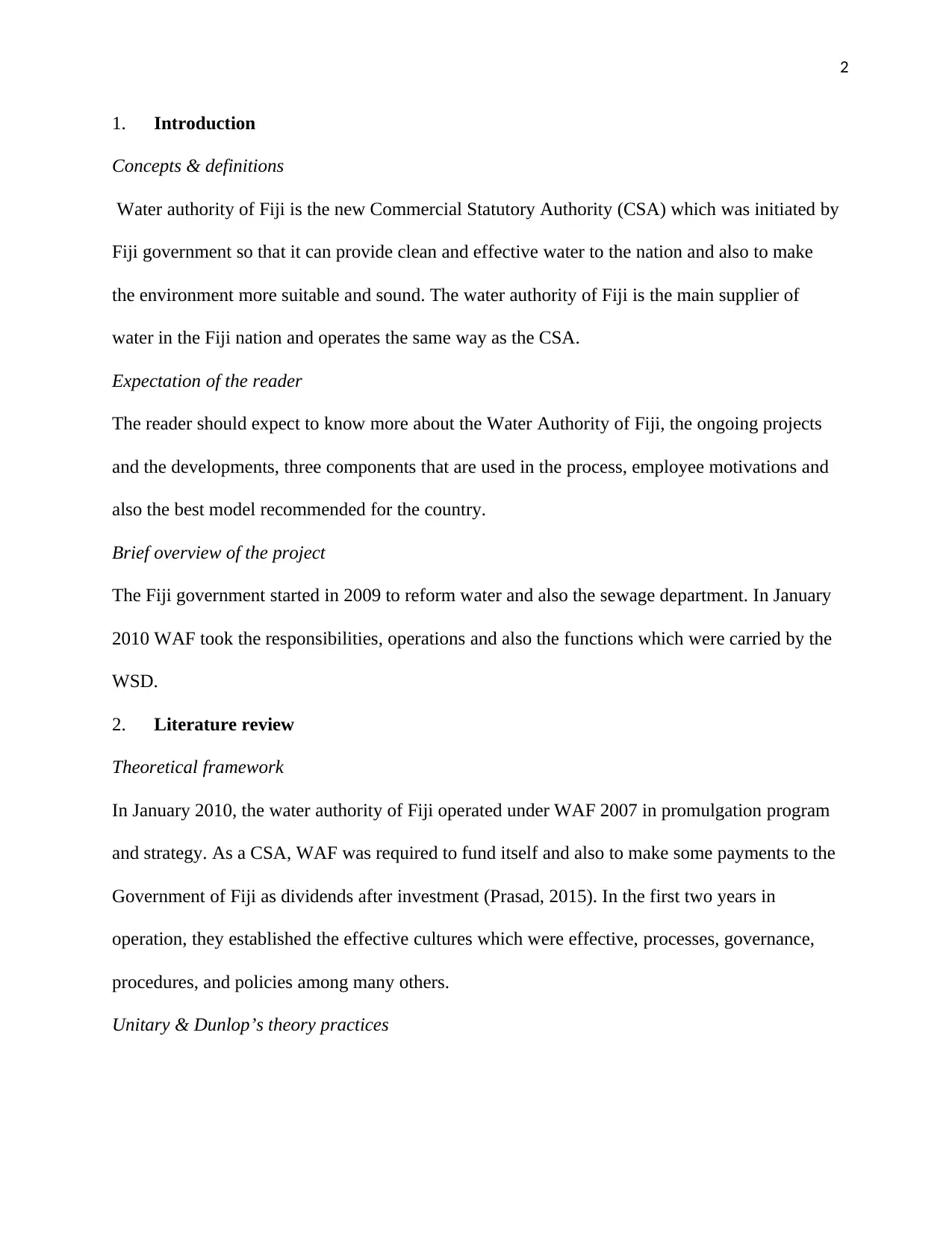
2
1. Introduction
Concepts & definitions
Water authority of Fiji is the new Commercial Statutory Authority (CSA) which was initiated by
Fiji government so that it can provide clean and effective water to the nation and also to make
the environment more suitable and sound. The water authority of Fiji is the main supplier of
water in the Fiji nation and operates the same way as the CSA.
Expectation of the reader
The reader should expect to know more about the Water Authority of Fiji, the ongoing projects
and the developments, three components that are used in the process, employee motivations and
also the best model recommended for the country.
Brief overview of the project
The Fiji government started in 2009 to reform water and also the sewage department. In January
2010 WAF took the responsibilities, operations and also the functions which were carried by the
WSD.
2. Literature review
Theoretical framework
In January 2010, the water authority of Fiji operated under WAF 2007 in promulgation program
and strategy. As a CSA, WAF was required to fund itself and also to make some payments to the
Government of Fiji as dividends after investment (Prasad, 2015). In the first two years in
operation, they established the effective cultures which were effective, processes, governance,
procedures, and policies among many others.
Unitary & Dunlop’s theory practices
1. Introduction
Concepts & definitions
Water authority of Fiji is the new Commercial Statutory Authority (CSA) which was initiated by
Fiji government so that it can provide clean and effective water to the nation and also to make
the environment more suitable and sound. The water authority of Fiji is the main supplier of
water in the Fiji nation and operates the same way as the CSA.
Expectation of the reader
The reader should expect to know more about the Water Authority of Fiji, the ongoing projects
and the developments, three components that are used in the process, employee motivations and
also the best model recommended for the country.
Brief overview of the project
The Fiji government started in 2009 to reform water and also the sewage department. In January
2010 WAF took the responsibilities, operations and also the functions which were carried by the
WSD.
2. Literature review
Theoretical framework
In January 2010, the water authority of Fiji operated under WAF 2007 in promulgation program
and strategy. As a CSA, WAF was required to fund itself and also to make some payments to the
Government of Fiji as dividends after investment (Prasad, 2015). In the first two years in
operation, they established the effective cultures which were effective, processes, governance,
procedures, and policies among many others.
Unitary & Dunlop’s theory practices
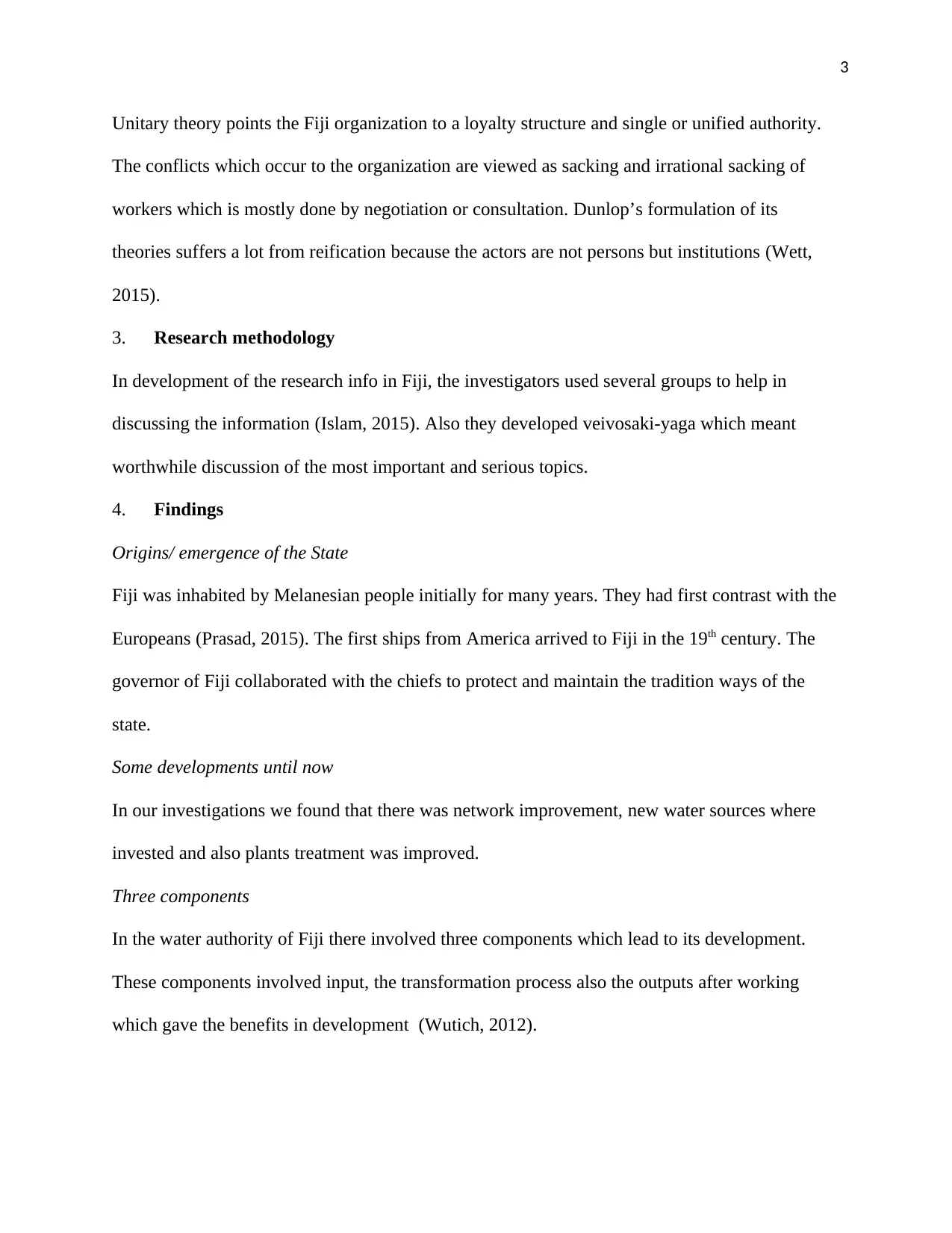
3
Unitary theory points the Fiji organization to a loyalty structure and single or unified authority.
The conflicts which occur to the organization are viewed as sacking and irrational sacking of
workers which is mostly done by negotiation or consultation. Dunlop’s formulation of its
theories suffers a lot from reification because the actors are not persons but institutions (Wett,
2015).
3. Research methodology
In development of the research info in Fiji, the investigators used several groups to help in
discussing the information (Islam, 2015). Also they developed veivosaki-yaga which meant
worthwhile discussion of the most important and serious topics.
4. Findings
Origins/ emergence of the State
Fiji was inhabited by Melanesian people initially for many years. They had first contrast with the
Europeans (Prasad, 2015). The first ships from America arrived to Fiji in the 19th century. The
governor of Fiji collaborated with the chiefs to protect and maintain the tradition ways of the
state.
Some developments until now
In our investigations we found that there was network improvement, new water sources where
invested and also plants treatment was improved.
Three components
In the water authority of Fiji there involved three components which lead to its development.
These components involved input, the transformation process also the outputs after working
which gave the benefits in development (Wutich, 2012).
Unitary theory points the Fiji organization to a loyalty structure and single or unified authority.
The conflicts which occur to the organization are viewed as sacking and irrational sacking of
workers which is mostly done by negotiation or consultation. Dunlop’s formulation of its
theories suffers a lot from reification because the actors are not persons but institutions (Wett,
2015).
3. Research methodology
In development of the research info in Fiji, the investigators used several groups to help in
discussing the information (Islam, 2015). Also they developed veivosaki-yaga which meant
worthwhile discussion of the most important and serious topics.
4. Findings
Origins/ emergence of the State
Fiji was inhabited by Melanesian people initially for many years. They had first contrast with the
Europeans (Prasad, 2015). The first ships from America arrived to Fiji in the 19th century. The
governor of Fiji collaborated with the chiefs to protect and maintain the tradition ways of the
state.
Some developments until now
In our investigations we found that there was network improvement, new water sources where
invested and also plants treatment was improved.
Three components
In the water authority of Fiji there involved three components which lead to its development.
These components involved input, the transformation process also the outputs after working
which gave the benefits in development (Wutich, 2012).
⊘ This is a preview!⊘
Do you want full access?
Subscribe today to unlock all pages.

Trusted by 1+ million students worldwide
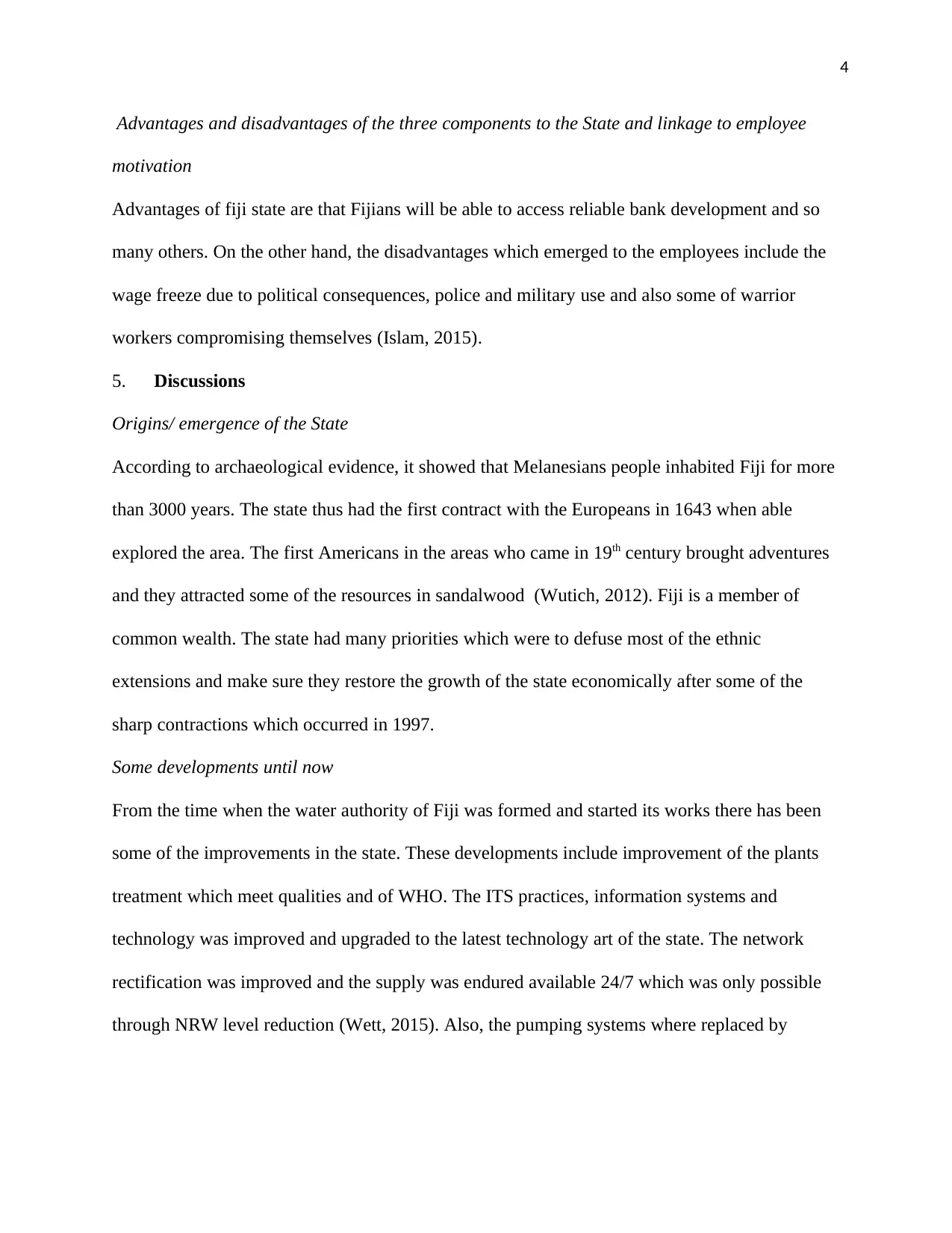
4
Advantages and disadvantages of the three components to the State and linkage to employee
motivation
Advantages of fiji state are that Fijians will be able to access reliable bank development and so
many others. On the other hand, the disadvantages which emerged to the employees include the
wage freeze due to political consequences, police and military use and also some of warrior
workers compromising themselves (Islam, 2015).
5. Discussions
Origins/ emergence of the State
According to archaeological evidence, it showed that Melanesians people inhabited Fiji for more
than 3000 years. The state thus had the first contract with the Europeans in 1643 when able
explored the area. The first Americans in the areas who came in 19th century brought adventures
and they attracted some of the resources in sandalwood (Wutich, 2012). Fiji is a member of
common wealth. The state had many priorities which were to defuse most of the ethnic
extensions and make sure they restore the growth of the state economically after some of the
sharp contractions which occurred in 1997.
Some developments until now
From the time when the water authority of Fiji was formed and started its works there has been
some of the improvements in the state. These developments include improvement of the plants
treatment which meet qualities and of WHO. The ITS practices, information systems and
technology was improved and upgraded to the latest technology art of the state. The network
rectification was improved and the supply was endured available 24/7 which was only possible
through NRW level reduction (Wett, 2015). Also, the pumping systems where replaced by
Advantages and disadvantages of the three components to the State and linkage to employee
motivation
Advantages of fiji state are that Fijians will be able to access reliable bank development and so
many others. On the other hand, the disadvantages which emerged to the employees include the
wage freeze due to political consequences, police and military use and also some of warrior
workers compromising themselves (Islam, 2015).
5. Discussions
Origins/ emergence of the State
According to archaeological evidence, it showed that Melanesians people inhabited Fiji for more
than 3000 years. The state thus had the first contract with the Europeans in 1643 when able
explored the area. The first Americans in the areas who came in 19th century brought adventures
and they attracted some of the resources in sandalwood (Wutich, 2012). Fiji is a member of
common wealth. The state had many priorities which were to defuse most of the ethnic
extensions and make sure they restore the growth of the state economically after some of the
sharp contractions which occurred in 1997.
Some developments until now
From the time when the water authority of Fiji was formed and started its works there has been
some of the improvements in the state. These developments include improvement of the plants
treatment which meet qualities and of WHO. The ITS practices, information systems and
technology was improved and upgraded to the latest technology art of the state. The network
rectification was improved and the supply was endured available 24/7 which was only possible
through NRW level reduction (Wett, 2015). Also, the pumping systems where replaced by
Paraphrase This Document
Need a fresh take? Get an instant paraphrase of this document with our AI Paraphraser
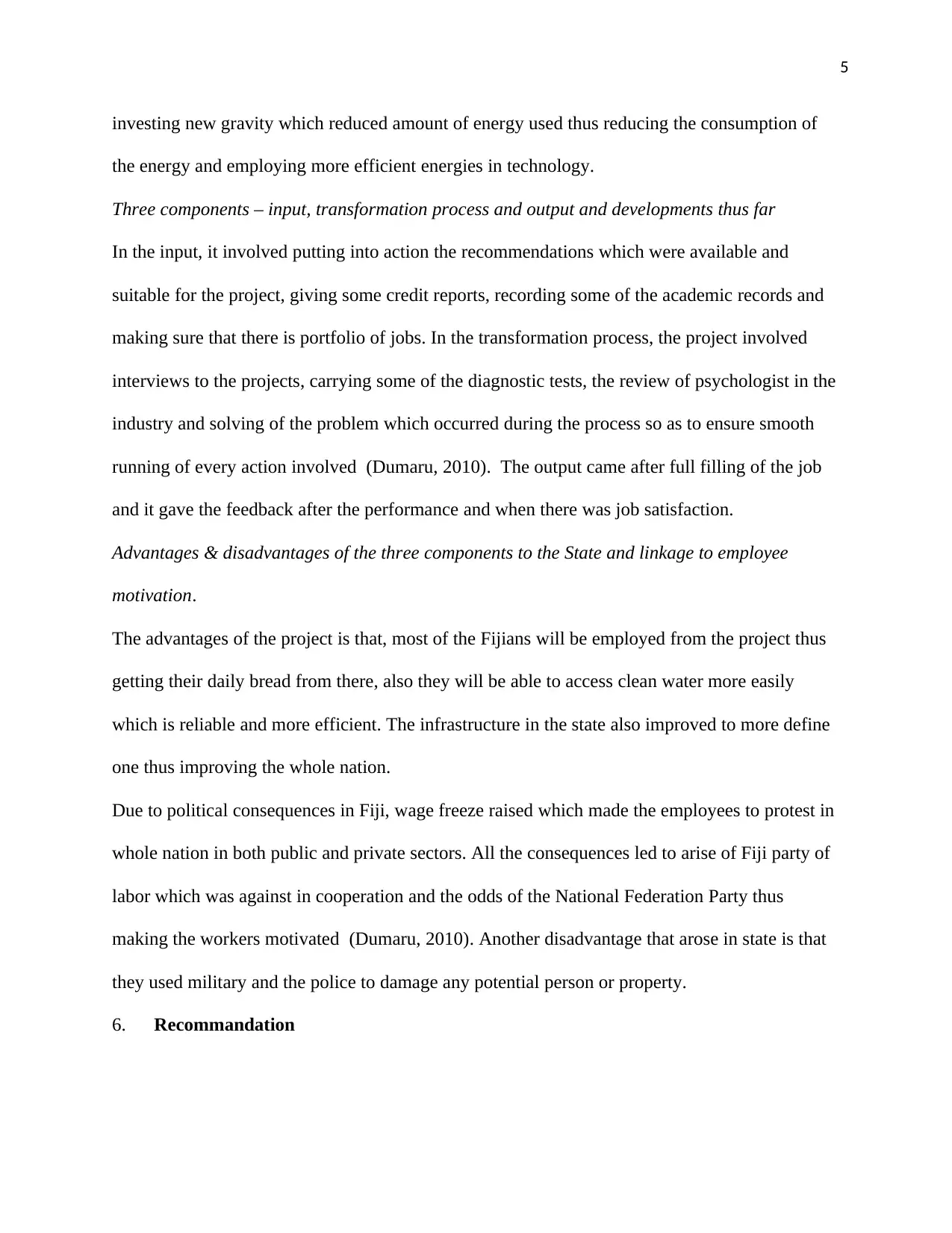
5
investing new gravity which reduced amount of energy used thus reducing the consumption of
the energy and employing more efficient energies in technology.
Three components – input, transformation process and output and developments thus far
In the input, it involved putting into action the recommendations which were available and
suitable for the project, giving some credit reports, recording some of the academic records and
making sure that there is portfolio of jobs. In the transformation process, the project involved
interviews to the projects, carrying some of the diagnostic tests, the review of psychologist in the
industry and solving of the problem which occurred during the process so as to ensure smooth
running of every action involved (Dumaru, 2010). The output came after full filling of the job
and it gave the feedback after the performance and when there was job satisfaction.
Advantages & disadvantages of the three components to the State and linkage to employee
motivation.
The advantages of the project is that, most of the Fijians will be employed from the project thus
getting their daily bread from there, also they will be able to access clean water more easily
which is reliable and more efficient. The infrastructure in the state also improved to more define
one thus improving the whole nation.
Due to political consequences in Fiji, wage freeze raised which made the employees to protest in
whole nation in both public and private sectors. All the consequences led to arise of Fiji party of
labor which was against in cooperation and the odds of the National Federation Party thus
making the workers motivated (Dumaru, 2010). Another disadvantage that arose in state is that
they used military and the police to damage any potential person or property.
6. Recommandation
investing new gravity which reduced amount of energy used thus reducing the consumption of
the energy and employing more efficient energies in technology.
Three components – input, transformation process and output and developments thus far
In the input, it involved putting into action the recommendations which were available and
suitable for the project, giving some credit reports, recording some of the academic records and
making sure that there is portfolio of jobs. In the transformation process, the project involved
interviews to the projects, carrying some of the diagnostic tests, the review of psychologist in the
industry and solving of the problem which occurred during the process so as to ensure smooth
running of every action involved (Dumaru, 2010). The output came after full filling of the job
and it gave the feedback after the performance and when there was job satisfaction.
Advantages & disadvantages of the three components to the State and linkage to employee
motivation.
The advantages of the project is that, most of the Fijians will be employed from the project thus
getting their daily bread from there, also they will be able to access clean water more easily
which is reliable and more efficient. The infrastructure in the state also improved to more define
one thus improving the whole nation.
Due to political consequences in Fiji, wage freeze raised which made the employees to protest in
whole nation in both public and private sectors. All the consequences led to arise of Fiji party of
labor which was against in cooperation and the odds of the National Federation Party thus
making the workers motivated (Dumaru, 2010). Another disadvantage that arose in state is that
they used military and the police to damage any potential person or property.
6. Recommandation
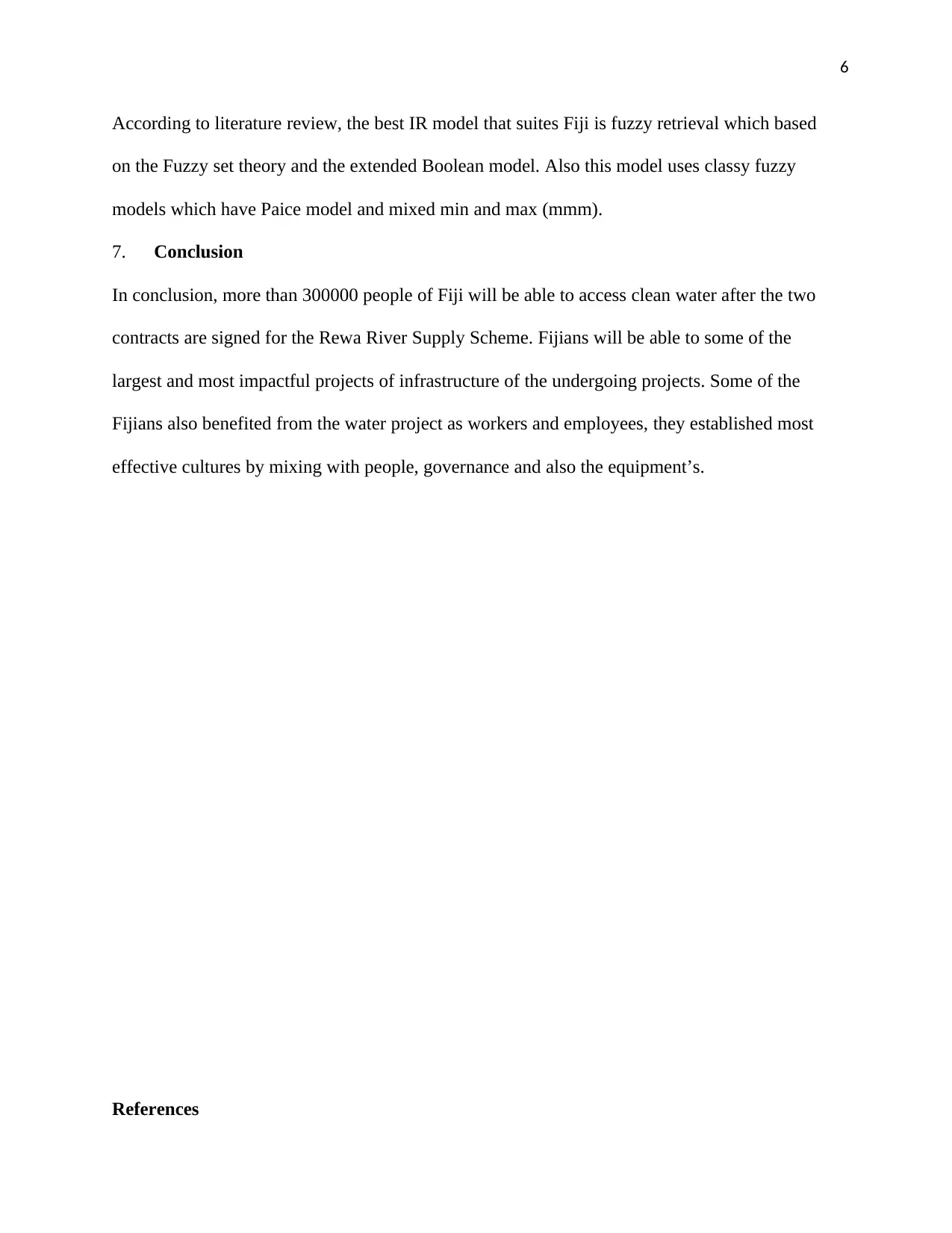
6
According to literature review, the best IR model that suites Fiji is fuzzy retrieval which based
on the Fuzzy set theory and the extended Boolean model. Also this model uses classy fuzzy
models which have Paice model and mixed min and max (mmm).
7. Conclusion
In conclusion, more than 300000 people of Fiji will be able to access clean water after the two
contracts are signed for the Rewa River Supply Scheme. Fijians will be able to some of the
largest and most impactful projects of infrastructure of the undergoing projects. Some of the
Fijians also benefited from the water project as workers and employees, they established most
effective cultures by mixing with people, governance and also the equipment’s.
References
According to literature review, the best IR model that suites Fiji is fuzzy retrieval which based
on the Fuzzy set theory and the extended Boolean model. Also this model uses classy fuzzy
models which have Paice model and mixed min and max (mmm).
7. Conclusion
In conclusion, more than 300000 people of Fiji will be able to access clean water after the two
contracts are signed for the Rewa River Supply Scheme. Fijians will be able to some of the
largest and most impactful projects of infrastructure of the undergoing projects. Some of the
Fijians also benefited from the water project as workers and employees, they established most
effective cultures by mixing with people, governance and also the equipment’s.
References
⊘ This is a preview!⊘
Do you want full access?
Subscribe today to unlock all pages.

Trusted by 1+ million students worldwide
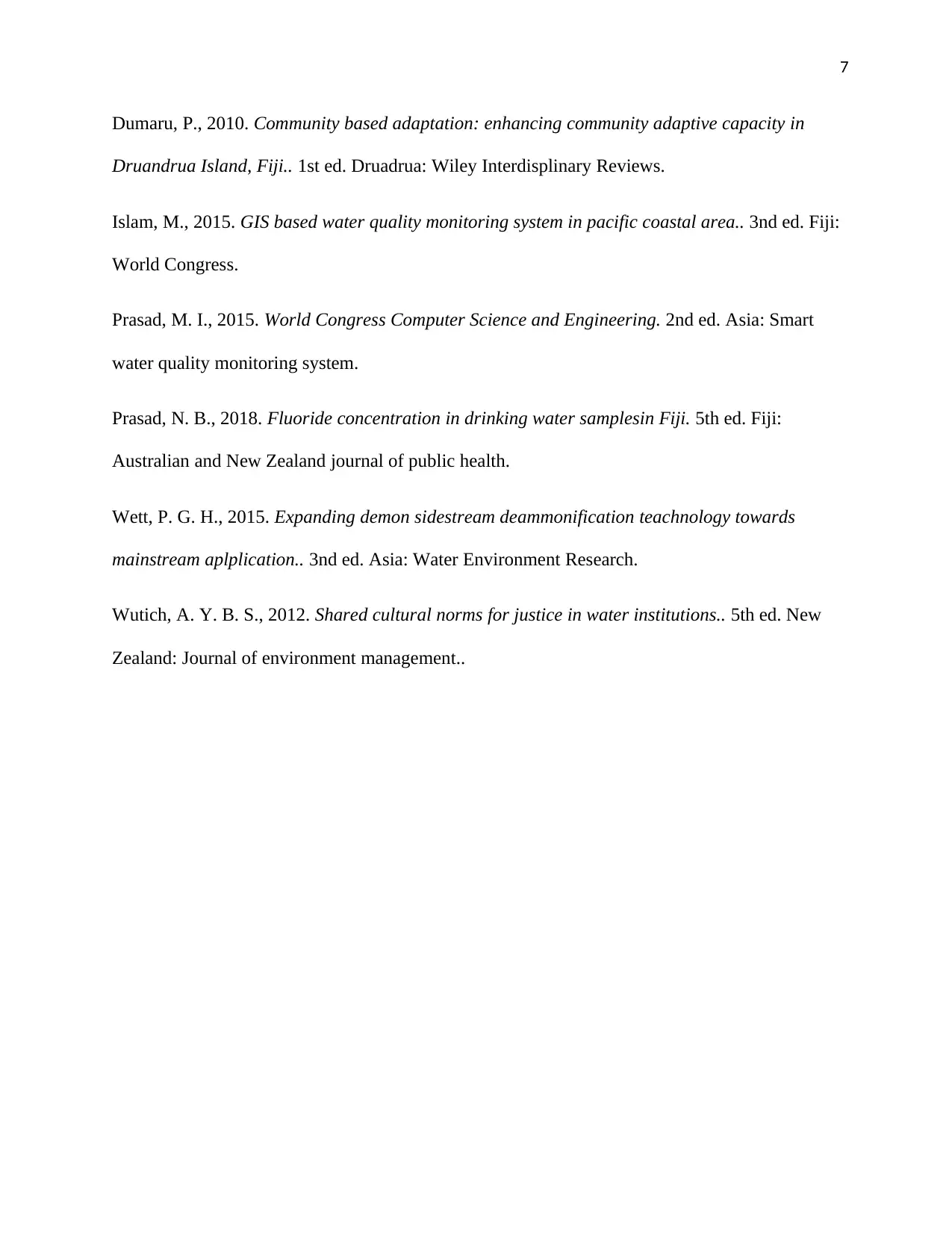
7
Dumaru, P., 2010. Community based adaptation: enhancing community adaptive capacity in
Druandrua Island, Fiji.. 1st ed. Druadrua: Wiley Interdisplinary Reviews.
Islam, M., 2015. GIS based water quality monitoring system in pacific coastal area.. 3nd ed. Fiji:
World Congress.
Prasad, M. I., 2015. World Congress Computer Science and Engineering. 2nd ed. Asia: Smart
water quality monitoring system.
Prasad, N. B., 2018. Fluoride concentration in drinking water samplesin Fiji. 5th ed. Fiji:
Australian and New Zealand journal of public health.
Wett, P. G. H., 2015. Expanding demon sidestream deammonification teachnology towards
mainstream aplplication.. 3nd ed. Asia: Water Environment Research.
Wutich, A. Y. B. S., 2012. Shared cultural norms for justice in water institutions.. 5th ed. New
Zealand: Journal of environment management..
Dumaru, P., 2010. Community based adaptation: enhancing community adaptive capacity in
Druandrua Island, Fiji.. 1st ed. Druadrua: Wiley Interdisplinary Reviews.
Islam, M., 2015. GIS based water quality monitoring system in pacific coastal area.. 3nd ed. Fiji:
World Congress.
Prasad, M. I., 2015. World Congress Computer Science and Engineering. 2nd ed. Asia: Smart
water quality monitoring system.
Prasad, N. B., 2018. Fluoride concentration in drinking water samplesin Fiji. 5th ed. Fiji:
Australian and New Zealand journal of public health.
Wett, P. G. H., 2015. Expanding demon sidestream deammonification teachnology towards
mainstream aplplication.. 3nd ed. Asia: Water Environment Research.
Wutich, A. Y. B. S., 2012. Shared cultural norms for justice in water institutions.. 5th ed. New
Zealand: Journal of environment management..
1 out of 7
Your All-in-One AI-Powered Toolkit for Academic Success.
+13062052269
info@desklib.com
Available 24*7 on WhatsApp / Email
![[object Object]](/_next/static/media/star-bottom.7253800d.svg)
Unlock your academic potential
Copyright © 2020–2025 A2Z Services. All Rights Reserved. Developed and managed by ZUCOL.
